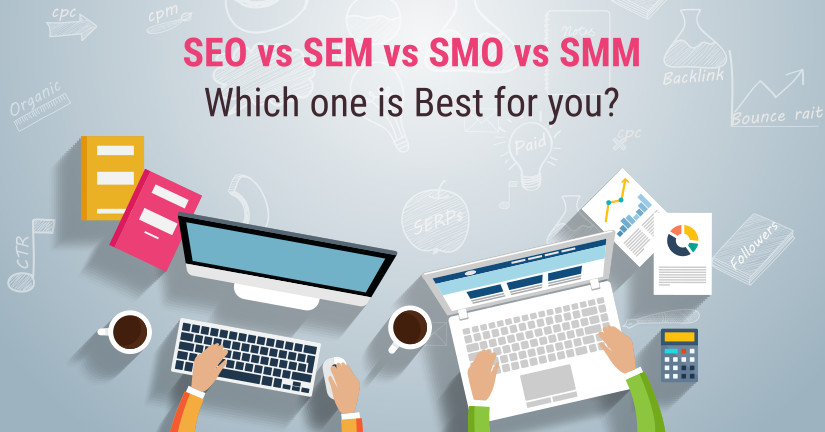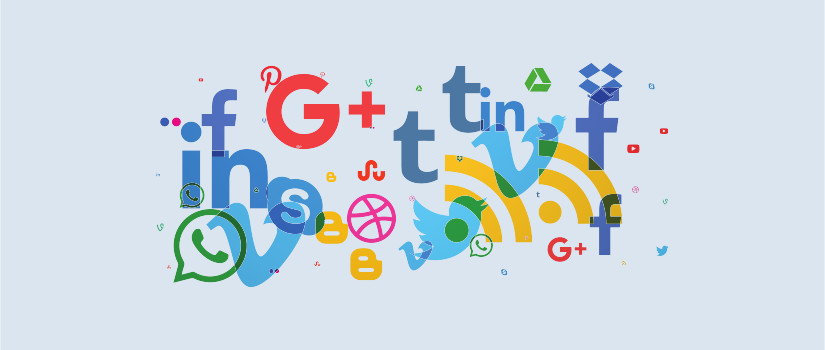SEO vs SEM vs SMO vs SMM: Which one is best for you?

Internet Marketing can be a daunting task even for the most technologically savvy person! So what is it that makes some websites stand out and make money, while other sometimes even better websites lack the traffic that they deserve? Read on to find out, and give your website the boost it needs.
For some of us, SEO, SMO, SEM, and SMM, might as well be gibberish, however, these are the terms that lead to an increase in traffic and ultimately money. Falling under the umbrella term of Internet Marketing, these are some acronyms that you need to know and understand before you dive into experimenting with them. In layman’s terms, there are two ways to generate traffic, one is through organic search (SEO) and the other is through paid search (SEM). So in the battle of SEO vs SEM, which one wins? Traffic coming from SEO is almost always free, whereas traffic coming from SEM is not! But before we get into the nitty-gritty of Organic vs Paid, the ideal thing is to first understand SEO and SEM, along with SMO and SMM.
SEO, SMO, SEM, and SMM: What actually do the acronyms mean?
SEO (Search Engine Optimization)

It deals with a website’s ranking on a Search Engine Result Page (SERP). The technique of SEO is to improve the search engine rankings of a website, give it more visibility and hence, more traffic. The technique involves optimizing the website, adding keywords in the Title, Meta tags, content and Meta description, frequently updating a website and increasing the speed at which it loads on a desktop and mobile device.
This means that if your website is optimized according to the SEO techniques, the chances that your website will appear on the first and second position in SERP for search queries related to your work is very high!
The different SEO techniques that you can use to optimize your website are as follows
On Page Optimization: The first thing you can do on a web page is to optimize it for keywords. For example, you can include a particular keyword at a density ratio of 2-3% in your web page, you can also use that keyword in the file name, the title of the page, the Meta description, along with using the keyword in the title of the page.
Off Page Optimization: This kind of optimization can be done by getting backlinks from other relevant websites. For example, you can optimize your page by seeking one-way backlinks from websites with a higher ranking, and to make sure that the link includes your keyword in the anchor text. This would bring not only quality backlinks but chances of higher ranking.
Black Hat SEO Technique: This technique uses strategies that get higher rankings, however, as the name suggests these techniques are unethical and not appreciated by popular search engines. The Black Hat SEO techniques include using break search engine regulations, offer a bad user experience, and present content in not so visual a manner. These techniques work in the beginning, but websites tend to get banned for them. So, it is better to stir away from them completely.
White Hat SEO Techniques: The exact opposite of Black Hat SEO technique is White Hat SEO technique since it is ethical and abides by all the rules Google sets from time to time for Search Engine Optimization. This technique which involves optimizing the websites according to the set rules, like making the website keeping in focus user experience, increasing the loading speed of websites by removing unnecessary advertisements and making web pages responsive, along with following other guidelines. This technique takes time but has far greater benefits than Black Hat SEO technique will ever have.
SMO (Social Media Optimization)

It means developing profiles on social media networks about your business/website such that members of that network can view and share your profile/page with others. For example, you have a blog, the best way to promote it is to create a Facebook, Twitter, Instagram and LinkedIn profile and share relevant information with people that may be interested in your work. This can work as a gateway to acquire a large audience and generate traffic to your website without spending a penny. All you need to do is choose the right social media channel for your business/website and follow some good set of guidelines to promote that.
SEM (Search Engine Marketing)

Closely associated with SEO, SEM can simply be defined as using paid search engine traffic to gain visibility. Paid results tend to appear on the top right-hand side of the ‘organic’ search results. The largest platforms for using SEM are Google, AdWords, Yahoo!, Microsoft adCenter and Search Marketing.
SEM has a lot of features and tools that have been developed by ad platform creators for webmasters. If you wish to enter the field of paid traffic, you need to consider all keywords associated with it, such as geographic location, Click Through Rates (CTR), Cost Per Click (CPC), advertisement copy and may other factors.
PPC, or pay per click, is one of the major techniques of SEM to drive in traffic. When a PPC campaign is launched you don’t have to wait for days to see the results, because they happen almost immediately. When SEO vs SEM are compared, with SEO you are at the mercy of search engine algorithms and updates, PPC, a feature of SEM gives you more control. It works quickly and brings in a lot of traffic that not just increases visibility, but allows you to customize your ads on the basis of geographic location, time of day and your budget. However, it can be risky, if not used in an optimum manner, and without keeping a short-term and long-term plan in mind, because the moment you stop your PPC campaign, you may not get as many hits.
SMM (Social Media Marketing)

It means promoting a channel through social media channels. Social Media Marketing gives you a chance to tap into a huge social media community available on several channels. It tends to also include ‘Paid Social Search’ or paid advertising on social media channels. Although paid social search is similar to SEM, it adds behavioral tendency into the search equation. The major part of the advertising is, however, the same as SEM, where an advertiser only pays when a user clicks on his or her advertisement.
A Gist of SEO vs SEM vs SMO vs SMM
| SEO | SEM | SMO | SMM | |
| Traffic | Organic | Paid | Organic | Paid |
| Benefits | Long-term | Short-term | Long-term | Short-term |
| Optimization via | Sharing relevant information | Keywords, and optimized web pages | Visual appeal, and relevant information | Visually attractive advertisements |
| Platforms | Facebook. Twitter, LinkedIn, Instagram, Snapchat | Google, Bing, Yahoo! and other search engines | Google, Bing, Yahoo! and other search engines | Facebook. Twitter, LinkedIn, Instagram, Snapchat |
SEO VS SEM
Now that you know what the terms SEO and SEM mean, along with the different techniques that fall under it. The result of the SEO vs SEM battle is quite simple.
- SEO tends to give back quality hits, and higher rankings but that may take years. SEM, on the other hand, is quick and tends to give you instant results, like a lot of hits in a very short period of time.
- SEO vs SEM can be simple explained. SEO is equity, where you add something every few days and get results later, SEM, on the other hand, is the instant result for every rupee spent. As the rupee stops coming in, so do the benefits.
In the short term battle of SEO vs SEM – SEM comes out the obvious winner.
In the long term battle of SEO vs SEM – SEO wins hands down.
Similarly, is we were to see SMO vs SMM, they would as similar as SEO vs SEM respectively. Giving back the same results.
So where should your investment go? Organic (SEO, SMO) or Paid (SEM, SMM)?
The simple answer is – BOTH! There remains no SEO vs SEM when you come down to business. They are all two sides of the same coin, one requires time and effort, the other requires money. Other than Black Hat SEO, all the above techniques are required if you wish to get higher rankings in SERP, more visibility, and more traffic. However, the deciding factor about your campaign working or is not based on using all these techniques, but on how efficiently you use them. This requires you to have an iron-clad business campaign.
The Best way to make the best campaign for your Business/Website is to keep the following things in mind
Your budget
The first thing, to begin with, is to know your budget, or how much are you willing to spend. If you are a small business, you may not want to lose your money on pointless campaigns that yield no results. Squandering money on campaigns without really understanding them, will cost you more than you wish to spend. So get a financial management in the plan. Understand the market, the techniques that would work best for your niche, understand the SEO vs SEM differences and then go on to planning a campaign.
Short and Long-term Plan
Once that is in place, you need to decide what your plans are. If you have just started out, understand the output of SEO vs SEM, want visibility your best bet is to invest in SEM strategies. You can use your budget for paid ads, to test for new features that you may have implemented, to see and analyzed consumer behavior by looking for keywords that match closely with your website. It is then that you should start investing your time in organic traffic. Since organic traffic relies on keywords, optimization and user behavior, you can use the analysis from SEM campaigns to implement it to make your website SEO friendly.
Quality and Quantity
Another major thing to keep in mind is the subtle line between quantity and quality. Some may want to stick with SEO in the SEO vs SEM battle, while some would go with SEM. Paid traffic is higher in the number of users that will visit your website, however, there is no promise of quality and no guarantee that once you end the campaign, the benefits of it won’t end as well. More often than not, they will.
Access market competition
If you are of the kind that doesn’t believe that SEO vs SEM is even a thing and they can exist simultaneously, you need to then understand the marketing techniques of your competitors. Your best bet is research. Find out what your competitors spend on, the keywords that they use, types of techniques that they use. Figure out the SERP competition through Google’s Keyword Planner and find out the target keywords that best suit your purpose. Since PPC relies on bids rather than keywords, you need to find out how much you are willing to pay for a single keyword click. This would help you channel your budget in a manner which is not just effective but also doesn’t burn a hole in your pocket.
Hit and Try: A/B Test your Campaigns
Having said everything above, the truth is there is no definite answer to what works. The question of SEO vs SEM may confuse you to no end. No one except you can clear that. It’s a hit and try the method. No one except you can answer that. You launch one campaign, it does well. Do it again. If a campaign fails, remove it, or reshape it to suit your purpose. In the end, it’s about optimizing your website to enhance the user experience, such that it ranks higher on the search results page, along with adding features that do not get you banned, and implementing plugins that give you the best bang for your bucks!
As easy as it may sound, we know it isn’t. Generating organic, quality traffic requires time, creativity and patience. Whereas generating paid, quantity traffic requires money. However, this daunting task can be easier if you build your website from scratch, and then adding campaigns to it that are well researched. Users that can code, have it easy anyway. But users that don’t, can rely on a web design software called TemplateToaster. The software allows users to build their own websites and gives them options to choose from multiple themes that are SEO friendly, offering full compatibility with all marketing techniques.
Build a Stunning Website in Minutes with TemplateToaster Website Builder
Create Your Own Website Now
Very good article ! Thanks !!
I love that explanation. Much appreciated
Hello, Param
I want to know how can we do SEO on Facebook, Instagram, and others??.. I use Facebook, Myspace, Twitter, LinkedIn and some other social networking website for SMO. But, I am confused how can we use these site for SEO?…
Thanks,
wow great article explained everything in very detail, Impressed
Wow the information you have put up are for more helpful to relevant topic , I am waiting for your next update.
Awesome post. Thank you!
I guess it’s all depend on the marketing goals of your company..
This the perfect explanation of all marketing streams. I like this article.
I understand from this article that the paid traffic is just the quantity of traffic, and by the use of free marketing we can focus on the quality of traffic right?
Usually we all busy within SEO and SEM, but this article makes the best explanation of all streams very well, thanks for posting.
I love the way you mention the information regarding Digital marketing streams. It really helps.
Wow! amazing article, I was looking for it for a long time, now I got the right difference and explanation about all digital marketing
Nowadays are important for every business for promoting their products and services.